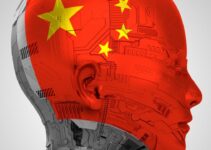China had a rough ride in 2022.
Throughout the year, the economy was plagued by the frequent resurgence of Covid and the related containment measures that disrupted daily activities. In the first three quarters, China’s GDP grew by 4.8%, 0.4%, and 3.9% from last year, falling far short of its own 5.5% annual growth goal.
The country’s tech industry was, of course, not immune to the overall sluggish economy. Chinese companies (many of which are in the tech sector) on the Hurun Global 500, a list that tracks the world’s most valuable companies, lost $2.9 trillion in 2022, more than half of their value from last year.
The e-commerce and content sectors, in particular, saw the most damage as consumers and advertisers cut spending. Industry leader Alibaba reported a steep drop in revenue growth, while budget retailer Pinduoduo saw rapid growth as people became more sensitive to prices. Content giant Tencent also reported quarterly revenue declines, and advertising revenue dropped significantly.
Meanwhile, green energy vehicle sales had been a rare growth point in China, and Chinese shopping platforms were rising rapidly in overseas markets despite challenges at home.
It might be too early to tell whether the country is nearing a turning point. After three years of battling the highly mutable and transmissible Covid-19, the Chinese government suddenly relaxed its Covid control policies in early December, exiting from its previously strict measures in less than a week. Such drastic change has resulted in rapid Covid infections across China, triggering drug shortages and causing many people to stay home to recover.
China’s earlier-than-expected reopening could bring an economic recovery in 2023. But the country might also need some time to learn to live with Covid after three years of strict controls.
Goldman Sachs expected China to reopen in the second quarter of 2023 in their annual China outlook report published in November and forecasted China’s GDP growth to “accelerate from 3.0% this year to 4.5% next year.” The first quarter after reopening might see negative growth, due to Covid case surges and people temporarily reducing travel, the report said. However, China might see accelerated growth once people adjust to the new reality, as experiences from other East Asian countries that have implemented strict Covid controls show.
EVs drive automaker growth, BYD claims dominance
In a year of lackluster consumer confidence, new energy vehicles (NEVs, including plug-in hybrids and electric vehicles) have been a rare bright spot in China. The country’s car buyers showed a strong preference for NEVs over traditional gas cars. The share of NEVs in the new car sales reached 36.2% in November, growing from last year’s 22.5% and surpassing China’s goal of 25% by 2025, three years ahead of schedule.
And no Chinese automaker had a better year than BYD. The local EV and battery maker climbed to a dominant position in the new energy vehicle segment. At the same time, China’s leading EV trio — Nio, Xpeng, and Li Auto — faced various problems and lost some of their shine.
BYD managed to capture market share from other strong rivals this year. In a year, BYD grew its share of NEV sales from 19.5% to 31%, while Wuling’s went down from 14.4% to 8%, and Tesla China went down from 10.7% to 7.9%.
As of November, BYD more than doubled its sales from last year, selling more than 1.57 million NEVs this year in China, taking more than 31% of the market share, ranking first and way ahead of the trailing pack of automakers. Wuling, a state-owned mini EV maker, is second, selling more than 400,000, growing 7.1% from last year, and accounting for more than 8% of the market. Tesla’s China operation came in third, with more than 397,800 cars sold, a 59% annual growth, and a 7.9% market share. Li Auto, Xpeng, and Nio ranked 10th, 11th, and 12th, each taking less than 2.3% of the market, down about 1% from last year.
Other local automakers, such as Geely, GAC’s Aion, Chery, Changan, and Hozon, also had a good year and grew their market share, though the speed and scale of BYD’s growth were unrivaled. Hozon made it into the top ten EV brands by sales for the first time this year, squeezing out the state-owned joint venture SAIC. Geely also saw impressive market share growth, rising from 2.7% last year to 5.3% this year.
BYD has two main advantages: competitive pricing and an integrated supply chain. BYD’s popular models — BYD Song Plus and BYD Qin — have been frequent bestsellers in their categories in the last six months. Priced between RMB 150,000 and RMB 220,000 ($21,470 to $31,490), these models are known for affordability and fuel efficiency. Unlike many other automakers hit by supply chain crunch and price hikes of source materials, BYD was able to keep its competitive price as a major battery maker in its own right (and one that is reportedly set to supply its blade battery to Tesla). BYD is also expanding outside China, systematically entering Japan, Southeast Asia, and Western Europe, with more overseas pushes planned ahead.
However, such impressive growth could slow in 2023. Multiple automakers in China gave conservative outlooks for the first half of 2023, citing the end of EV purchase subsidies at the end of 2022. Many brands also cut prices and gave out promotions to attract buyers to place orders before the end of 2022, boosting their year-end sales and capitalizing on the last subsidy run. These moves are likely to overdraft 2023’s sales in advance.
Pinduoduo wins in China, competition heats up in overseas markets
In the economic downturn, budget retailer Pinduoduo outrivaled established platforms like Alibaba and JD. In the third quarter, Pinduoduo reported 65% growth in revenue and a whopping 388% growth in operating profit, contrasting with Alibaba’s relatively flat growth of 3% in revenue and 68% in operating profit, and JD’s 11.4% growth in revenue and 276% in operating profit. Alibaba fared worse than JD, seeing a steep drop in revenue growth, with yearly growth hitting below 10% for the first three quarters of 2022, a major departure from the 20% or 30% plus growth rates it has been accustomed to in the past few years.
Although Pinduoduo’s vice president of finance, Liu Jun, said at a third-quarter earnings call that the company was “unlikely to maintain” that level of profitability, the temporary strong growth still showed the broad appeal of a well-run budget retailer during lean times.
China’s year-end shopping festival Singles Day was also increasingly losing its appeal. Industry leaders Alibaba and JD didn’t release their overall sales data for the first time in a decade. Moreover, these established retailers were also facing serious threats from ByteDance’s Douyin as the short-video platform continues to see strong growth in live commerce.
In contrast to the slow growth back home, outside of China, competition has been heating up for Chinese overseas retail platforms. In March, Shein, the Chinese online fashion platform known for its ultra-cheap prices, managed to expand its market share of fast fashion sales in the US to 40%, continue to widen its lead over H&M’s 27%, Zara’s 17%, Forever 21’s 9% and Fashion Nova’s 6%, a report from Bloomberg Second Measure said. Shein became the largest fast-fashion retailer in the US in the second quarter of 2021 and grew its US sales more than 5.6 times between March 2020 and March 2022.
Seeing Shein’s success, Pinduoduo also launched an overseas retail platform Temu in September. The platform surpassed $1.5 million in average daily gross merchandise value (GMV) in its first month. Although the figure fell slightly short of internal expectations, the platform was spending heavily on ads to capture new customers, even becoming the most-downloaded shopping app in the US, surpassing Amazon, Walmart, and Shein. Nevertheless, it remains to be seen whether such growth is sustainable.
A somber year for China’s semiconductor industry
Since Chinese tech giants ZTE and Huawei began to be hit by US sanctions five years ago, the Chinese tech industry has wondered about the evolution of US sanctions. This fall, the multi-year effort hit a new level.
In October, the US announced a sweeping set of restrictions on semiconductor exports to China, aiming to cut China off from accessing high-end chips and the tools to make them. Instead of putting individual companies on blacklists, the new restrictions took aim at the entire Chinese semiconductor sector and related industries.
In particular, the Biden administration is trying to limit China’s ability to make advanced chips under 16nm or 14nm, DRAM memory chips of at least 18nm, and NAND flash memory chips of 128 layers or more. Meanwhile, the US is also pursuing chipmaking toolmakers in the Netherlands (ASML) and Japan (Tokyo Electron), pressuring them to stop selling China the tools to make high-end chips. There aren’t many ways around these curbs. Unless advanced chipmaking technology changes or undergoes a fundamental evolution, China’s dream of making its own advanced chips in the next few years might be limited.
Content platforms see ad revenue winter
The content and entertainment sectors have seen significant blows in the past year, not just in China, but also worldwide. According to the Hurun Global 500 list, media and entertainment companies suffered the most significant drop in value in 2022, followed by retail, software, and services, while the biggest gainers were in energy and insurance.
Major content platforms in China saw dwindling advertising dollars as companies cut marketing budgets to weather the economic downturn. Worse, whatever budget was left was increasingly going directly to e-commerce platforms such as Pinduodou and JD rather than content platforms like Tencent, Baidu, and Weibo.
Content giant Tencent saw yearly revenue decline by 3% and 2% in the second and third quarters, with advertising revenue down almost 18% in the second quarter. In late December, Tencent’s CEO Pony Ma said in an internal speech that the company could cut Tencent News, the company’s signature news website established in 2003, if the site can’t break even by itself.
Search engine giant Baidu also saw revenue decline by 5% in the second quarter, and a flat 1.9% growth in the third. Microblogging site Weibo saw heavy losses too, reporting 22% and 25% revenue declines in the second and the third quarter.
Gaming companies in China saw a few signs of easing conditions. In April, China began issuing gaming licenses again after an eight-month freeze. But heavy regulation on the sector in 2021 has continued to have ripple effects, and video game companies were projected to see a 2.5% annual revenue decline in 2022. Many smaller studios had to lay off staff or even shut down their companies while waiting for their new games to be approved by the authorities. The worst might be over, but the pain is still being felt throughout the industry.
Related reporting from TechNode
Auto
E-commerce
Semiconductors
Content


